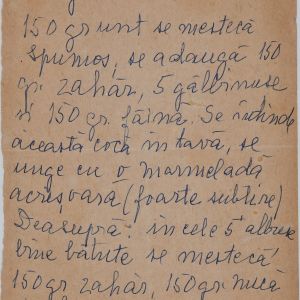Regele Carol I Boulevard
The Arendt confectionery in Timisoara was opened by Julius Arendt in 1929, in the Iosefin district, opposite the current "Merlin" Puppet Theater. The Arendt confectionery in Iosefin was one of the most famous places in Timisoara where sweets were sold and consumed.
Listen to the audio version.
The Julius Arendt confectionery in Iosefin was one of the best known in the inter-war period, located on the ground floor of a building built at the end of the 19th century in historic style with classicist accents, together with the extension of the Iosefin district to Cetate, the historical nucleus of Timișoara, and the organization of the buildings in this district on parcels.
The Arendt Confectionery in Timisoara was opened by Julius Arendt in 1928, in opposite to the building that currently houses the "Merlin" Children's and Youth Theater. The building which is in a state of advanced degradation is currently unoccupied. The Arendt confectionery was famous in Timisoara for the best „cremeș”, according to the confessions of Alfred Kosar, the nephew of Julius Arendt. After the nationalization of 1949, the "Oltul" buffet was operating in the premises, later the "Gospodina" store, and the famous confectioner Julius Arendt became an unskilled worker, later a cook at the canteen of the Tehnometal factory, and passed away in Timisoara in 1965.
In this video more information about the Arendt family is presented.
Listen to the audio version.
Julius Arendt sweet shop
Liana Maria Gombosoiu, Valeria Dr. Pintea. A family novel. Marineasa Publishing House, Timişoara, 2013, 148-149, 198
…we also met a lot of people, and, for those who knew her, grandmother became Valeria dr. Pintea, her speaking was more reserved, but not lacking affection and interest for anyone who stopped her. We went to one or another sweetshop, where Madame Doctor was immediately served with her favorite cake, were we inevitably greeted somebody sited at the next table, the smell of cream and of fresh dough made me dizzy, everything seemed elegant and distinguished. And the name of the cakes was enchanting: Marmorschnitte, Sacher Torte, Pischinger Torte…
Grandmother sent us, almost stubbornly, nicely handwritten recipes of her complicated cakes, that we would never do, or, had we tried to, we wouldn’t succeed to achieve something similar to those she did. She gave us the amounts in “deca”, the butter was not to be replaced for any reason with margarine, she told us to strictly observe the recipe, never to “abdicate” from the precision of the quantities and never stick to recipes from the “Kingdom” where measures like the cup, the spoon, the knife tip, the “idea”, the “as it encompasses”, “as needed”, “according to taste” were used. The fact that, in spite of measuring the ingredients precisely and observing all the instructions, we never obtained neither her famous “ischlers”, nor those delicious “Honigpusserli” gave her an undeclared satisfaction. She thus, until the end, detained the supremacy of some unrivaled sweets for which we praised her unreserved. Maybe thus she understood, after several decades, her mother in law, the priestess in Satulung, who kept the secret of the nut cake…




















